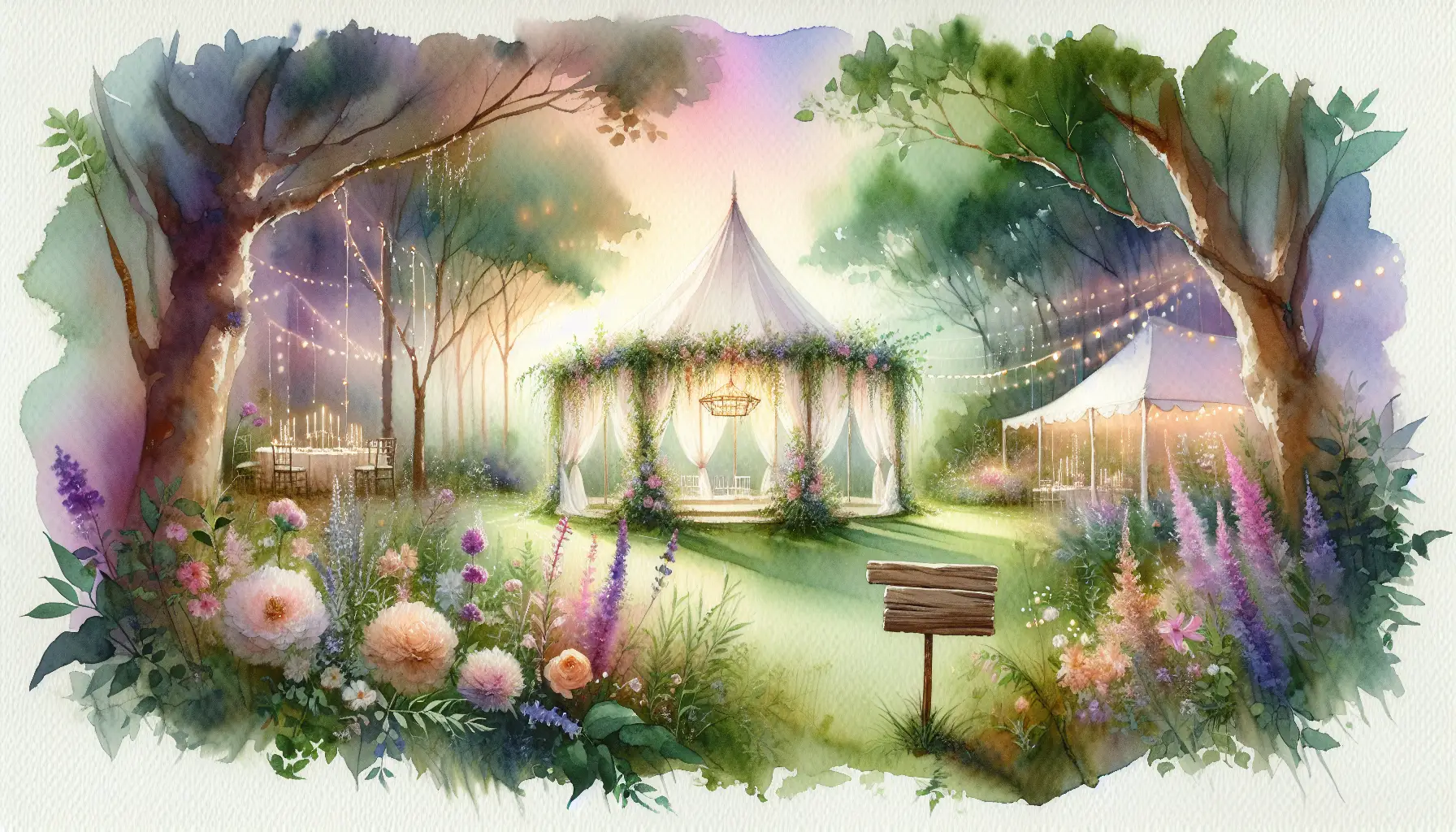This blog post may contain affiliate links. As an Amazon Associate I earn from qualifying purchases.
I’ve always believed a DIY wedding tent can add a personal touch to your big day. As someone who’s helped friends create their dream outdoor weddings, I know firsthand how a custom-made tent can transform a backyard into a magical venue. Not only does it give you control over the look and feel of your space, but it can also be a great way to save on wedding tent costs.
In this guide, I’ll walk you through the process of creating your own DIY wedding canopy. We’ll cover everything from planning and building the tent frame to installing the fabric and adding those special decorative touches. Whether you’re looking for backyard tent wedding ideas or want to learn how to construct a DIY party tent frame, I’ve got you covered. Let’s dive in and start bringing your wedding tent ideas to life!
Planning Your DIY Wedding Tent
When I plan a DIY wedding tent, I always start by assessing the venue. The size and shape of the tent directly impact how much fabric we’ll need and the length of supports. For a backyard tent wedding, I consider the guest count, seating arrangement, and extra space for a dance floor, DJ booth, and bar. A 40×60-foot tent can fit about 200 people for a cocktail-style setup. I also factor in weather conditions, as we might need extra secure fastenings in windy areas or water-resistant fabrics for rainy locales. Selecting the right fabric is crucial—lightweight options like tulle create an airy look, while heavier fabrics offer better wind resistance for cooler months.
Building the Tent Frame
When I start building a DIY wedding tent frame, I always begin with PVC pipes. They’re lightweight, affordable, and easy to work with. For a basic 20×15-foot tent, I use four 10-foot pipes for the tent poles, two 20-foot pipes, two 15-foot pipes, and four 12-foot 5-inch pipes for the peak. I connect these using PVC 4-way connectors. First, I secure the 10-foot pipes to the middle bottom holes of the connectors as tent poles. Then, I create the rectangle on the ground by connecting the 20 and 15-foot pipes. Next, I add the peak using the 12-foot 5-inch pipes. Finally, I link the top to the corners. To ensure stability, I stake the poles into the ground or use cement blocks.
Installing the Tent Fabric
Now that I’ve built the frame, it’s time to install the fabric for my DIY wedding tent. I start by draping the fabric over the crossbars, making sure it’s evenly distributed on both sides. For a 10-foot span, I use four pieces of fabric to create a fuller look. If you’re working with a larger tent, you might need more fabric to achieve the desired effect. I carefully pleat the fabric, overlapping each piece and securing them with zip ties to prevent separation in windy conditions. This method not only enhances the aesthetic appeal but also ensures the fabric stays in place throughout the celebration.
Decorating Your DIY Wedding Tent
When it comes to decorating my DIY wedding tent, I always start with lighting. String lights are a must-have for creating a magical atmosphere. I drape them across the ceiling and along the tent poles, making sure to secure them with zip ties. For a more dramatic effect, I add paper lanterns in various sizes and colors to complement my wedding theme. To create a focal point, I hang a statement chandelier above the dance floor or head table. This not only provides extra light but also adds a touch of elegance to the space. For table decor, I use a mix of candles and small floral arrangements to keep things simple yet beautiful.
Final Thoughts – Create a DIY Wedding Tent
Creating a DIY wedding tent has a significant impact on transforming a simple outdoor space into a magical wedding venue. This guide provides a comprehensive approach to plan, build, and decorate your own wedding canopy, giving you the tools to create a personalized and budget-friendly celebration. From choosing the right materials to adding those special finishing touches, the process allows couples to infuse their unique style into every aspect of their big day.
To sum up, a DIY wedding tent offers more than just cost savings – it provides an opportunity to create lasting memories and a truly one-of-a-kind wedding experience. By following these steps and adding your creative flair, you can craft a beautiful, intimate space that reflects your love story. Remember, the key to a successful DIY wedding tent lies in careful planning, attention to detail, and most importantly, enjoying the journey of bringing your vision to life. ## FAQs
FAQs
What size should a wedding tent be to accommodate 100 guests?
For a gathering of 100 people, a tent typically needs to be between 800 to 1,200 square feet in size. Remember to consider additional space for elements like bars, dance floors, gift tables, food stations, or special displays.
How can I enhance the appearance of a tent for a wedding?
To beautify a wedding tent, consider incorporating elements such as a hanging flower garden, romantic twinkle lights, a draped fabric ceiling, monogrammed accents, structured open-air designs, sparkling chandeliers, and partially draped setups.
How do I put together an event tent?
The assembly process for an event tent includes setting up the frame, usually made of steel or aluminum poles, and then covering it with the tent fabric. Ensure all connections are secure and check the manufacturer’s instructions, as each model may have specific requirements.
How much fabric is required to drape a wedding tent?
To calculate the amount of fabric needed to drape a tent, add together the lengths of all four sides. For instance, a tent measuring 40 feet by 60 feet would require 200 linear feet of fabric (40+60+40+60).


